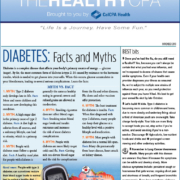Sweet Talk For Healthy Blood Sugar
 Diabetes is a condition where the body can’t make insulin, or can’t use it well. Insulin is a hormone that helps our bodies get energy from the glucose in the food we eat. Without it, glucose levels in the blood stream are too high. Over time, this can cause damage to your body tissue and organs.1
Diabetes is a condition where the body can’t make insulin, or can’t use it well. Insulin is a hormone that helps our bodies get energy from the glucose in the food we eat. Without it, glucose levels in the blood stream are too high. Over time, this can cause damage to your body tissue and organs.1
There are three main types of diabetes.1
- Type 1 diabetes can affect anyone, but most often it develops in children or young adults. People with this type of diabetes produce very little insulin, or none at all.
- Type 2 diabetes is the most common type. People with type 2 diabetes either make too little insulin, or their bodies aren’t able to use it effectively.
- Gestational diabetes (GDM) is a form of diabetes that appears during pregnancy. While GDM usually goes away after pregnancy, it puts women and their babies at higher risk for type 2 diabetes.
Prevention
Type 1 diabetes can’t be prevented. But healthy habits can help lower your risk of getting type 2 diabetes.3,5
- Get to or stay at a healthy body weight. Each pound you lose lowers your risk.
- Exercise each day, for 30 to 60 minutes.
- Make healthy choices about food. Eat more fruits and veggies, and pay attention to your portion sizes. Limit foods that are high in sugar, fat, or sodium.
- Quit smoking. The more cigarettes you smoke, the higher your risk for type 2 diabetes. Quitting smoking can be hard – get help if you need it.4
- Get the right amount of sleep. Sleeping less than six or more than nine hours per night can put you at a higher risk.
Talk to your doctor about your risk factors, and what you can do to lower your risk.
Control blood sugar before it controls you
If you are older than 45, you should have a blood sugar test at least every three years. If you are in a high-risk
group, you should have the test more often. You also should start at a younger age.3
Your risk is higher if you are:3
- Overweight.
- African American, Alaska Native, American Indian, Asian American, Hispanic or Pacifi c Islander American.
- A woman who had diabetes during pregnancy.
- Aged 60 or older.
Almost half of all people with diabetes don’t know they have it. That puts them at high risk for dangerous
complications.2 People with diabetes are more likely to suffer from heart attacks, strokes, kidney disease, and dental problems. Complications from diabetes can cause nerve problems that lead to the loss of fingers, toes and limbs. The disease can also cause loss of eyesight, and even early death.3
Change before you have to
Lowering your risk prevents health problems. One way to do that is to make sure your blood sugar, blood pressure and cholesterol are where your doctor says they should be.
Sources:
1 International Diabetes Federation website: About Diabetes (accessed December 2014): idf.org.
2 International Diabetes Federation website: Diabetes: Facts and Figures (accessed December 2014): idf.org.
3 National Institute of Diabetes and Digestive and Kidney Diseases website: Am I at Risk for Type 2 Diabetes? Taking Steps to Lower Your Risk of Getting Diabetes (accessed December 2014): diabetes.niddk.nih.gov/dm/pubs/riskfortype2.
4 Centers for Disease Control and Prevention website: Tips From Former Smokers: Smoking and Diabetes (accessed December 2014): cdc.gov/tobacco/campaign/tips/diseases/diabetes.
5 International Diabetes Federation website: Prevention (accessed December 2014): idf.org.


Leave a Reply
Want to join the discussion?Feel free to contribute!